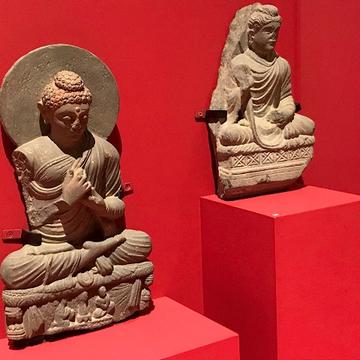
On Thursday, 9 November, over 40 students, staff, and faculty visited the Ashmolean Museum to view the “Imagining the Divine” exhibition. After walking through the exhibition, the group engaged in a lively discussion with the exhibition’s curator, Jaś Elsner (Professor of Late Antique Art), in the Headley Lecture Theatre. The visit was organized by Hindy Najman (Oriel and Laing Professor of the Interpretation of Holy Scripture), with assistance from Arjen Bakker (Lecturer in Hebrew Bible, Oriel College) and Olivia Stewart Lester (John Fell Postdoc at the Faculty of Theology and Religion). The event was supported by Prof Najman’s Centre for the Study of the Bible in the Humanities (CBH) at Oriel College. Prof Najman hosted the event in the context of the Old Testament/Hebrew Bible seminar and the Early Biblical Interpretation seminar, and created a unique opportunity for interaction between members of different faculties and subject areas (Old Testament, New Testament, Patristics, the Oxford Centre for Hebrew and Jewish Studies, and Oriental Studies). Examples of biblical interpretation in “Imagining the Divine” were of special interest to seminar participants, but the exhibition also prompted much larger conversations about the role material culture plays in our understanding of religion in antiquity, including the suggestion that we view texts as objects alongside other, more traditional artistic objects. Prof Elsner’s talk and responses to the group’s questions illuminated the logic and organization of the exhibition, emphasizing the importance of imagining the objects in the collection as they would have originally been used, and it also challenged the group to re-think religious traditions beyond those represented in the exhibition, including mysticism and astrology. The visit to this remarkable exhibition was greatly enriched by the discussion with Prof Elsner. Many members of the group expressed deep appreciation for the insights Prof Elsner shared about the issues facing art history/archaeology as it moves toward religion and for religious studies as it turns to material culture.
Seated Buddha on the left. Carved schist. Gandhara, 1st-2nd century: The Buddha sits in meditation with his hands in the teaching gesture. The drapery of his robes is based on Roman and Greek sculpture, his posture on Indian images of holy men and teachers, and the halo, used to indicate his divinity, is a very old symbol used throughout Asia.
Seated Buddha on the right. Carved schist. Gandhara, 3rd-4th century. The Buddha makes a gesture of reassurance by raising his right hand and facing the palm towards the viewer. Many different deities were depicted in this way in India. As artists developed new images of the Buddha, they invented new hand gestures to represent particular ideas or moments in his life.